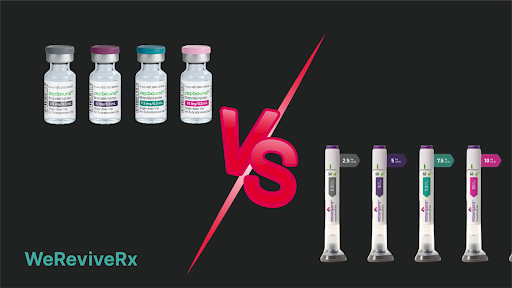Zepbound vs Mounjaro: Are They the Same?
Zepbound vs Mounjaro: Are They the Same?

Introduction
If you’ve heard of Zepbound and Mounjaro, you might be wondering—what’s the difference?
Spoiler: they both contain the same active ingredient (tirzepatide), but they’re FDA-approved for different purposes.
In this blog, we’ll break down Zepbound vs Mounjaro—what’s the same, what’s different, and when it matters (especially for insurance, cost, and availability).
Quick Comparison
|
Feature |
Zepbound |
Mounjaro |
|
FDA Approved For |
Chronic weight management |
Type 2 diabetes |
|
Active Ingredient |
Tirzepatide |
Tirzepatide |
|
Launch Year |
2023 |
2022 |
|
Dosing |
Weekly injection (5–15 mg) |
Weekly injection (5–15 mg) |
|
Insurance Coverage |
Sometimes covered (weight loss) |
Often covered (diabetes) |
|
Savings Programs |

What’s the Same?






What’s Different?
|
Category |
Zepbound |
Mounjaro |
|
FDA Approval |
Weight loss (BMI-based) |
Type 2 diabetes only |
|
Labeling |
Prescribed for obesity |
Prescribed for blood sugar control |
|
Insurance Access |
Less commonly covered (2024–2025) |
Widely covered for diabetes |
|
Cost (U.S. retail) |
~$1,060/month |
~$1,060/month |
|
Online Prescriptions |
Easier access via telehealth for weight loss |
Requires diabetes diagnosis |
Can You Use Mounjaro for Weight Loss?
Yes—but that’s called off-label use, meaning it’s being prescribed for a condition not officially approved by the FDA.

- Your insurance doesn’t cover Zepbound
- You meet the clinical criteria for medical obesity
- You’re paying out of pocket or using a savings card

Which Is Cheaper?


|
Medication |
Cost with Savings Card |
Notes |
|
Zepbound |
As low as $25/month |
Requires commercial insurance |
|
Mounjaro |
As low as $25/month |
For Type 2 diabetes only |

Who Should Use Zepbound?

- BMI ≥30, or
- BMI ≥27 with a weight-related condition (PCOS, hypertension, etc.)
- No diagnosis of diabetes
- Goals focused on fat loss and long-term weight management
Who Should Use Mounjaro?

- Diagnosed Type 2 diabetes
- A1C above 7.0% despite other medications
- Insurance plans that cover diabetes meds more easily
- Need for blood sugar control + weight loss benefits
Can You Switch Between Zepbound and Mounjaro?
Yes—since they are formally identical medications, many providers allow switching depending on:
- Insurance coverage
- Supply shortages
- Pricing strategies
Always discuss with your provider to ensure proper documentation and approval.
Final Thoughts
Zepbound and Mounjaro are essentially the same drug—but with different FDA approvals, insurance coverage rules, and prescribing patterns. The best option for you often depends on your health history and how you plan to pay.




